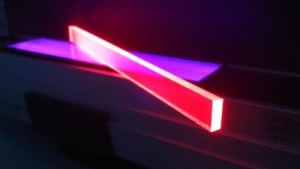Apr 15 2014
A house window that doubles as a solar panel could be on the horizon, thanks to recent quantum-dot work by Los Alamos National Laboratory researchers in collaboration with scientists from University of Milano-Bicocca (UNIMIB), Italy. Their project demonstrates that superior light-emitting properties of quantum dots can be applied in solar energy by helping more efficiently harvest sunlight.
 Quantum dot luminescent solar concentrator devices (embedded in the glowing pink bar) under ultraviolet illumination. (PRNewsFoto/Los Alamos National Laboratory)
Quantum dot luminescent solar concentrator devices (embedded in the glowing pink bar) under ultraviolet illumination. (PRNewsFoto/Los Alamos National Laboratory)
"The key accomplishment is the demonstration of large-area luminescent solar concentrators that use a new generation of specially engineered quantum dots," said lead researcher Victor Klimov of the Center for Advanced Solar Photophysics (CASP) at Los Alamos.
Quantum dots are ultra-small bits of semiconductor matter that can be synthesized with nearly atomic precision via modern methods of colloidal chemistry.
A luminescent solar concentrator (LSC) is a photon management device, representing a slab of transparent material that contains highly efficient emitters such as dye molecules or quantum dots. Sunlight absorbed in the slab is re-radiated at longer wavelengths and guided towards the slab edge equipped with a solar cell.
Klimov explained, "The LSC serves as a light-harvesting antenna which concentrates solar radiation collected from a large area onto a much smaller solar cell, and this increases its power output."
"LSCs are especially attractive because in addition to gains in efficiency, they can enable new interesting concepts such as photovoltaic windows that can transform house facades into large-area energy generation units," said Sergio Brovelli, a faculty member at UNIMIB.
Because of highly efficient, color-tunable emission and solution processability, quantum dots are attractive materials for use in inexpensive, large-area LSCs. To overcome a nagging problem of light reabsorption, the Los Alamos and UNIMIB researchers developed LSCs based on quantum dots with artificially induced large separation between emission and absorption bands (called a large Stokes shift).
These "Stokes-shift" engineered quantum dots represent cadmium selenide/cadmium sulfide (CdSe/CdS) structures in which light absorption is dominated by an ultra-thick outer shell of CdS, while emission occurs from the inner core of a narrower-gap CdSe.
Los Alamos researchers created a series of thick-shell (so-called "giant") CdSe/CdS quantum dots, which were incorporated by their Italian partners into large slabs (sized in tens of centimeters) of polymethylmethacrylate (PMMA). While being large by quantum dot standards, the active particles are still tiny - only about hundred angstroms across. For comparison, a human hair is about 500,000 angstroms wide.
A journal article is in Nature Photonics at http://dx.doi.org/10.1038/NPHOTON.2014.54